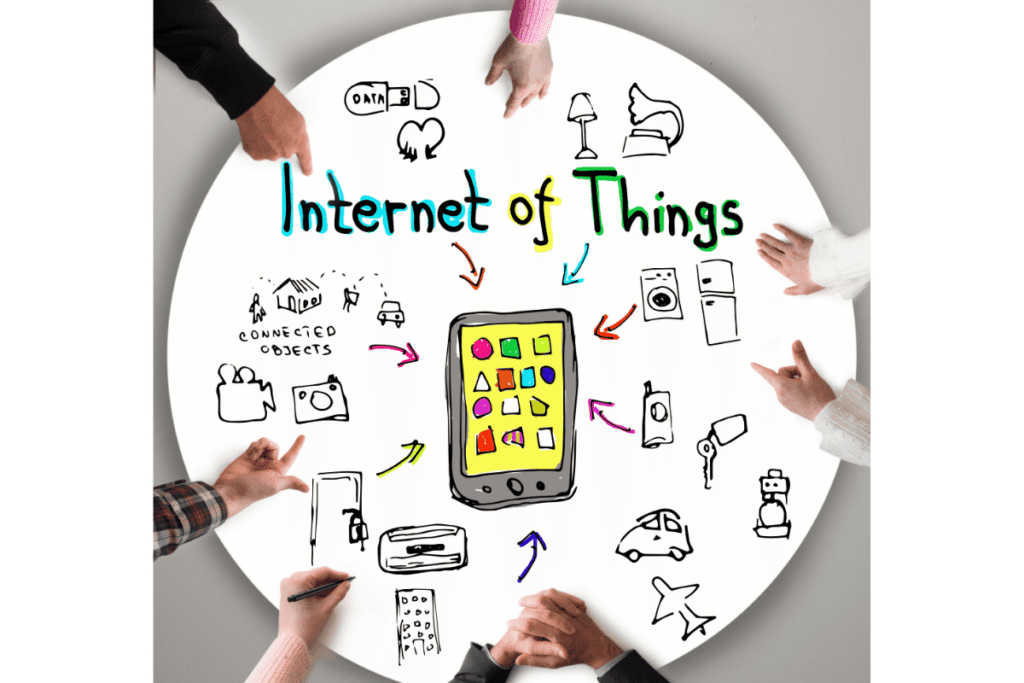The Pros and Cons of IoT: Exploring the Advantages and Disadvantages of IoT (Internet of Things)

Have you ever wondered about the underlying benefits and drawbacks that come with our increasingly interconnected world? The Internet of Things, or IoT, has become a revolutionary force in modern day technology. This blog will guide you through an insightful journey exploring the pros and cons of IoT so you can better understand its impact on our lives.
Stick around to learn how the conveniences come with hidden challenges!
Key Takeaways
- IoT offers automation for improved efficiency, making tasks faster and easier.
- IoT promotes conservation and sustainability by saving energy and reducing carbon footprint.
- IoT provides an enhanced understanding of the world through real-time data collection and insights for better decision-making.
- However, there are concerns about increased tracking and privacy issues with IoT.
- Weaknesses in network security make IoT devices vulnerable to hacking and cyber-attacks.
- Higher bandwidth requirements challenge accessibility and network performance in certain areas.
- Increased monitoring time is required to ensure the proper functioning of IoT systems, which can lead to higher labor costs.
What are Some Pros Of IoT (Internet of Things)?

IoT offers automation for improved efficiency, allowing businesses to streamline processes and reduce manual labor.
Automation for improved efficiency
IoT makes tasks faster and easier. Smart devices can talk to each other. They do jobs without needing a person. This is called automation. It helps in many ways at home and at work.
A smart fridge lists what food you have inside it. Your smartphone gets this list from the fridge, even if you are not home! At work, IoT saves time too! Items in a store have sensors that know when they are running low or gone.
The store does not need to check manually anymore because the sensor sends an alert right away!
Conservation Options and sustainability
IoT makes saving energy easy. Think of a smart home. Smart bulbs turn off when no one is in the room. A smart thermostat can learn your schedule and adjust heat or air conditioning to save power.
This helps lower our energy use and carbon footprint for a greener planet. IoT also aids businesses looking to go green by tracking their energy usage in real-time, so they can find ways to cut back consuming too much power.
All this leads to great savings on electric bills and a big thumbs up for Mother Nature!
Enhanced understanding of the world
IoT makes it easy to know about the world. It gives you real-time data. You can see changes in weather, traffic and more using IoT. This tech lets us track health with fitness trackers or even smart watches.
These devices tell your heart rate, steps walked, and sleep score. It helps doctors to take care of patients better.
You get a lot of new information from IoT devices. People learn new things all the time with this tech! Corporations use IoT for actionable data to make smart choices about business operations.
We have discovered many things we didn’t know before because of it!
Data collection for insights and decision-making
IoT devices collect data from various sources, like sensors and smart devices, to provide valuable insights that can inform decision-making. This data can be used in many industries, such as healthcare, energy management, and transportation.
For example, in the healthcare industry, wearable devices track vital signs and health information to help doctors monitor patients remotely. In energy management, IoT devices gather data on electricity usage to identify areas where energy can be conserved.
These insights enable businesses to make informed decisions that optimize operations and improve efficiency. However, it is important to address concerns related to data security and privacy when collecting and using this data.
Do the Cons (Disadvantages of IoT) Outweigh the Advantages?

Increased tracking and privacy concerns. Weaknesses in network security. Higher bandwidth requirements. Increased monitoring time. Discover the potential downsides of the Internet of Things and how they can impact our daily lives, businesses, and overall security.
Read on to learn more and decide if these disadvantages outweigh the benefits!
Increased tracking and privacy concerns
One of the drawbacks of IoT is the increased tracking and privacy concerns. With the proliferation of internet-connected devices, there are more opportunities for companies and individuals to collect data about us without our knowledge or consent.
This raises questions about who has access to our personal information and how it will be used. Additionally, the more connected we become, the more vulnerable we are to cyber attacks and hacking attempts.
Our sensitive data could be exposed or misused, leading to identity theft or other harmful consequences. It is important for businesses and individuals alike to prioritize security measures and establish clear guidelines for data collection and usage in order to protect our privacy in an increasingly interconnected world.
Weaknesses in network security
There are some weaknesses in network security when it comes to the Internet of Things (IoT). One major concern is that IoT devices can be vulnerable to hacking and cyber attacks. Since these devices are connected to the internet, they may not have strong built-in security measures.
This means that hackers could potentially gain access to personal information or even take control of these devices. Another weakness is the lack of standardization in IoT security protocols, which makes it difficult for businesses and consumers to ensure consistent protection across all their devices.
It’s important for individuals and organizations to implement strong security measures like encryption and regular software updates to mitigate these risks.
Given the vulnerabilities and the vast number of devices associated with IoT, implementing a Zero Trust approach is highly recommended.
Higher bandwidth requirements
The Internet of Things (IoT) requires a lot of bandwidth. This means that more data needs to be sent and received for IoT devices to work properly. With so many devices connected to the internet, like smart homes and cities, there is a higher demand for fast and reliable internet connections.
This can be a challenge because not all areas have access to high-speed internet. In rural or remote locations, it may be difficult to get the necessary bandwidth for IoT devices. This can limit the adoption of IoT technology in these areas.
Moreover, with more data being transmitted over the network, there is also an increased risk of congestion and slower speeds. This can impact the performance and reliability of IoT systems.
Increased monitoring time
One of the cons of IoT is that it can lead to increased monitoring time. With the proliferation of connected devices and sensors, there is a need for constant monitoring and management of these devices.
This means that individuals or organizations may have to spend more time ensuring that their IoT systems are functioning properly and collecting accurate data. This can be particularly challenging in larger-scale deployments where there are numerous devices spread across different locations.
Furthermore, this increased monitoring time can also result in higher labor costs as additional resources may be required to handle the maintenance and surveillance of IoT systems.
The Future of IoT
The future of IoT looks promising and exciting. As technology continues to advance, we can expect even more connected devices and smart systems in our everyday lives. For example, imagine living in a fully automated home where you can control everything from your lights to your thermostat with just a few taps on your smartphone.
This level of convenience and control is what the future holds for us.
Moreover, IoT will play a significant role in making our cities smarter and more sustainable. With the help of sensors and data analytics, city infrastructure can be optimized to reduce energy usage, improve transportation efficiency, and enhance public safety.
For instance, smart traffic management systems can alleviate congestion by dynamically adjusting traffic signals based on real-time data.
Additionally, industries such as healthcare and manufacturing will greatly benefit from IoT advancements. Wearable devices that monitor vital signs or track physical activity can revolutionize healthcare by providing doctors with actionable data for diagnoses and treatment plans.
In manufacturing, IoT-enabled machines can communicate with each other to optimize production processes resulting in cost savings.
However, it’s important to remember that as IoT expands its reach, security concerns become more critical than ever before. Safeguarding sensitive information from hackers should always be a top priority when developing IoT technologies. Adopting a Zero Trust security model is one way to combat this risk.
Overall, the future of IoT holds great potential for enhancing our lives through automation and connectivity. By embracing this technology responsibly while addressing security challenges head-on, we can create a safer and more efficient world powered by the Internet of Things.
FAQs
1. What are the pros and cons of Internet of Things (IoT)?
The pros and cons of IoT involve it being a tool to optimize business processes, gain new consumer insights, and reduce costs but also has disadvantages like cyber security issues and possible unemployment for unskilled workers.
2. Can using IoT devices increase productivity?
Yes! IoT devices can help businesses improve customer experience, schedule maintenance more efficiently, save time in various industries resulting in higher productivity.
3. What could be the impacts on data privacy when deploying IoT devices?
Deploying IoT devices might bring along risks to cybersecurity since these tools collect large amounts of user data which if breached could be catastrophic.
4. Are there any compatibility issues with IoT?
Compatibility might pose a challenge as IoT devices from different manufacturers may not integrate well into larger systems or with each other.
5. How does the deployment of IoT affect operating costs?
The adoption of IoT devices can reduce operating costs by helping businesses optimize electricity use among others while improving ROI at same time.
6. How is the global internet of things market growing?
The global Internet Of Things market is set to grow globally even in 2022 leading to more savings for enterprises, cost-effective solutions for customers but concerns over unemployment remain.
Conclusion
In conclusion, the Internet of Things (IoT) has its advantages and disadvantages. While IoT offers convenience and efficiency through automation, there are concerns regarding privacy and security.
It is important to carefully consider and address these challenges to ensure successful implementation of IoT technology in our lives.
If you liked this article, remember to subscribe to MiamiCloud.com. Connect. Learn. Innovate.







